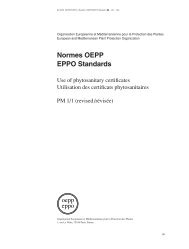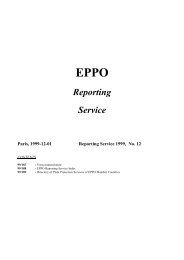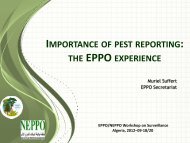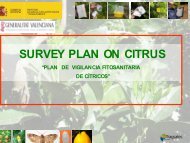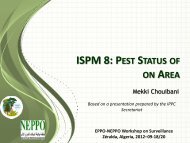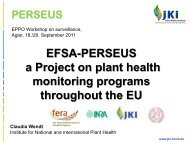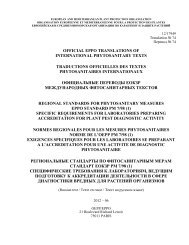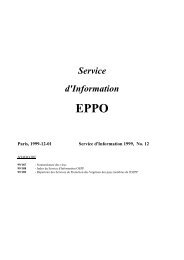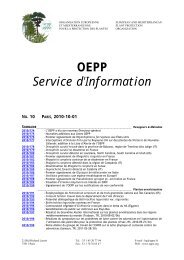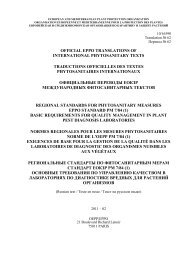EPPO Reporting Service - Lists of EPPO Standards - European and ...
EPPO Reporting Service - Lists of EPPO Standards - European and ...
EPPO Reporting Service - Lists of EPPO Standards - European and ...
You also want an ePaper? Increase the reach of your titles
YUMPU automatically turns print PDFs into web optimized ePapers that Google loves.
<strong>EPPO</strong> <strong>Reporting</strong> <strong>Service</strong> – Pests & Diseases<br />
under investigation. The area affected lies approximately 14 km west <strong>of</strong> Inverness,<br />
Scotl<strong>and</strong> <strong>and</strong> is confined to a small number <strong>of</strong> plantations amounting to approximately<br />
1400 hectares. Pest management options are still being evaluated.<br />
The pest status <strong>of</strong> Dendrolimus pini in the United Kingdom is <strong>of</strong>ficially declared as:<br />
Present, locally in forests in North-East Scotl<strong>and</strong> at low prevalence. Control measures<br />
are being evaluated.<br />
Source: NPPO <strong>of</strong> the United Kingdom, 2009-10.<br />
Additional key words: new record Computer codes: DENDPI, GB<br />
2010/009 Leptoglossus occidentalis: an invasive alien species spreading in Europe<br />
Leptoglossus occidentalis (Heteroptera: Coreidae – common names: western conifer seed<br />
bug or leaf-footed conifer seed bug) was first described in 1910 in California (US) <strong>and</strong> is<br />
considered as native to the western areas <strong>of</strong> North America, from Mexico in the south<br />
through California <strong>and</strong> Utah to British Columbia, Alberta, <strong>and</strong> Saskatchewan in the north.<br />
Since the end <strong>of</strong> the last century the range <strong>of</strong> this bug has been exp<strong>and</strong>ing, more<br />
particularly eastwards beyond the Rocky Mountains. In the 1950s <strong>and</strong> 1960s it reached<br />
Indiana, Iowa, Montana, Nebraska <strong>and</strong> Kansas. By the 1970s it was established in Wisconsin<br />
<strong>and</strong> Illinois, <strong>and</strong> by the mid 1980s it was found in Minnesota, Michigan, Ontario (Canada),<br />
<strong>and</strong> Connecticut. In the 1990s, it was reported from New York, Massachusetts, Rhode<br />
Isl<strong>and</strong>, New Hampshire, Maine, Pennsylvania <strong>and</strong> New Brunswick (Canada).<br />
In Europe, L. occidentalis was observed for the first time in 1999 in Northern Italy, <strong>and</strong><br />
within a very short time its presence was reported from more than 15 <strong>European</strong> countries<br />
(see below), thus clearly demonstrating an invasive behaviour. It is hypothetized that its<br />
current distribution in Europe probably results from several introductions which were then<br />
followed by natural spread. It is hypothetized that this insect may have been introduced<br />
through trade <strong>of</strong> timber. Interestingly, L. occidentalis was discovered for the first time in<br />
Asia in 2008; few specimens were observed in Tokyo, Japan.<br />
In North America, the main host plants <strong>of</strong> L. occidentalis are Pinus species <strong>and</strong><br />
Pseudotsuga menziesii, but the insect has also been found on Abies, Calocedrus decurens,<br />
Cedrus, Juniperus, Tsuga canadensis <strong>and</strong> Picea spp. Adults feed on flowers <strong>and</strong> seeds <strong>of</strong><br />
conifer species in spring. Females lay eggs on needles <strong>and</strong> young larvae feed primarily on<br />
developing cones <strong>and</strong> occasionally on needles. They insert their long proboscises into the<br />
cones to suck juices from the seeds (bugs remaining on the outside <strong>of</strong> the cone). There are<br />
five larval instars <strong>and</strong> adults appear during summer. In USA <strong>and</strong> Canada, the species is<br />
monovoltine, but in Mexico it is polyvoltine. Adults are the overwintering stage, <strong>and</strong> in<br />
autumn they look for shelter <strong>and</strong> may enter buildings, sometimes becoming a nuisance to<br />
humans. In USA, L. occidentalis is considered to be a pest <strong>of</strong> conifer cones, as its feeding<br />
activity can affect the seed production <strong>of</strong> conifer st<strong>and</strong>s.<br />
Many pictures <strong>of</strong> L. occidentalis can be found on the Internet, for example:<br />
http://www.inhs.uiuc.edu/~sjtaylor/coreidae/coreidae.html<br />
http://www.forestryimages.org/browse/subthumb.cfm?sub=459&start=1<br />
In Europe, no severe damage was reported in forests or conifer seed production, so far.<br />
However, it must be acknowledged that many records have been made by both amateur<br />
<strong>and</strong> pr<strong>of</strong>essional entomologists in cities, essentially in buildings or near parks <strong>and</strong> gardens.<br />
In many cases, it was not possible to associate pest records with observations on potential<br />
host plants. Therefore it seems desirable that studies on the distribution <strong>of</strong> L. occidentalis<br />
<strong>and</strong> the possible impacts <strong>of</strong> this invasive species on coniferous forest ecosystems or in<br />
urban environments should be conducted.<br />
8




